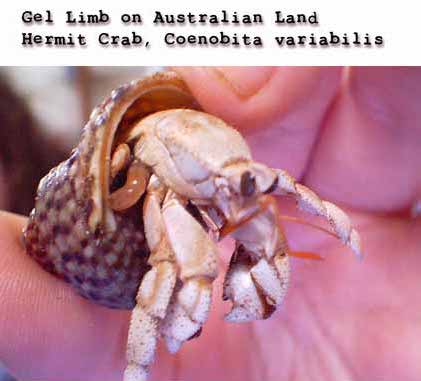What is Autotomy?
Comes from the latin words autos for “self” and tomos for “cut
Autotomy can be described as self-cutting, Websters dictionary describes autotomy as a “reflex separation of a part (as an appendage) from the body: division of the body into two or more pieces.” Hermit Crabs can autotomize (drop) and regenerate (regrow) their limbs from juvenile to adult stages. The break occurs along a fracture plane located at the appendage’s base.
Why do land hermit crabs drop limbs?
The rate at which the limbs regenerate depends upon the molt cycle (Morgan, 1900; Zeleny, 1908; Bliss, 1960; Skinner 1962, 1985). During aggressive encounters, a crab will often choose to flee and autotomize (self-amputate) the limb being held so that they can escape. Other reasons why a land hermit crab may self-amputate is in response to stress, ill health, to reduce blood loss from a wound, or as a response to the presence of bacteria or pests. (Cooper, 98). There is a thin grove on each crab appendage close to where it joins the body. This is the fracture plane, along with an internal membrane. Separation occurs instantly through
Stress from fluctuating temperatures
Hermit crabs are stressed by changes in environmental factors, it is too hot or cold, humid or dry. Some times when hermit crabs lose limbs it is a sign of stress or ill health. It is important to keep your crabarium as close to the environment they are used to in the wild. That means recreating the tropics which as we know means warmth and moisture.
Aggression
Another reason crabs loose a limb or a cheliped is when a crab moults and does not shed their entire exoskeleton in one piece, but instead section by section, over a number of days. Generally if they survive the moult they grow their limbs back again (regeneration) and can be happy and healthy.
There are cases where one hermit crab will act aggressively towards another hermit crab. It could be territorial or over a desired shell. In the wild a hermit crab will “throw” a claw or leg if another hermit crab tries to pull them out of their shell. This is a responsive behaviour and their limbs are built in a way that they are able to “drop” or “throw” a limb easily so they may survive an attack. This is called Autotomy.
When one crab likes another’s shell, say Crab A likes Crab B’s shell, Crab A will go up to Crab B’s shell, knock its shell ( that of Crab A) against the other crab’s shell (Crab B), causing the crab in the desired shell (Crab B) to come out and have a look at what is going on. Now the first crab will try to pull the second crab out of its shell by a cheliped or other limb. The second crab will normally drop his cheliped(grasping claw) or leg/s and retreat inside his shell, using his remaining cheliped to protect himself. Preferring to loose a limb instead of loosing a shell.
Illness from contaminated living conditions
There are many stores that do not meet the needs of the land hermit crabs they sell. If a tank is overcrowded, unclean and their lack of freshwater. It is important that you regularly clean the tank and remove any signs of contaminated foodstuffs or mouldy substrate.
Mite infestation
If your hermit crab tank has a mite infestation you will need to get rid of them ASAP! Visit the MITES page for more information
Why doesn’t the crab bleed to death?
The crab does not lose blood because it instantly clots. A second membrane helps in closing the wound, creating a nub-like covering which develops into a limb bud.
What happens next? Can they regrow the lost limb?
A nub-like covering developing into a limb bud, which is at first transparent and slowly unfolds. After one or more moults the bud (or ‘gel limb’ as it has been described) soon regenerates to the way it looked before the limb loss and will return to full size after a few moults. Sometimes this can trigger a number of moults one after the other as the crab struggles to regenerate all limbs successfully. Sensory neurons must grow and re-establish the appropriate connections with the neural network of the ventral nerve cord if the new limb is to exhibit its original function (Cooper, 98).
 |
Fig. 1. A dorsal view of the thoracic nerve cord dissected out of a crayfish but with two limbs still attached. The third left limb (second walking leg; ganglion T3) is a regenerated limb after one molt, at stage B. The second left limb (first walking leg; ganglion T2) is a regenerated limb after two molts. The roots were dissected free up to the autotomy plane. Note that the nerve bundles spread out and intermingle in a network of connective tissue at the autotomy plane. (Cooper, 1998) |
 |
Fig. 2 shows the stages of limb regeneration
Stage A: Papila stage Stage B: limb bud is very soft and just beginning to take on some distal features of the new limb Stage C: most distal features well differentiated Stage D: leg segments are discernible and muscles have some function since movements can be elicited Stage E: represemtatove of a typical pristine limb |








